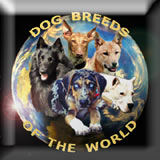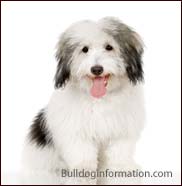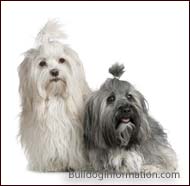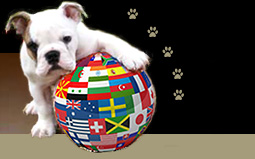Introduction
The Bichon family of dogs are a related non-sporting group of dog breeds, which share some common characteristics such as a curled tail, short muzzle, drop ears and round, dark eyes. Their main characteristic is their coat, which is composed of hair rather than fur, and can be curly or silky. Some of the breeds within this family are considered hypoallergenic because their low-shedding coat produces less dander.
Maltese
Photo by Eric Isselée
They were all selected to be small, elegant companion dogs with even, well-balanced characters and playful temperaments, good with children while maintaining alert watchdog abilities. The were much appreciated by noblemen and royals because they were non-shedding and odorless.
The most famous representative is probably the Bichon Frisé (sometimes referred to as just 'Bichon'), but the Bolognese, Havanese, Maltese, and probably the Coton de Tulear all belong to this family. The Löwchen (Little Lion dog) has long been considered a member of this family, but more recent research seems to indicate it has a completely different origin that pre-dates that of the Bichon dog breeds (see further).
Bichon Breeds
Bichons have a long, soft and dense coat, usually white, but each Bichon type has its own coat colors and texture besides the popular white:
Coton de Tulear:
A relatively quiet dog with few health problems and a cotton-like, not silky, coat (hence the name). Accepted coat colors are white, black and white or tricolored.
Havanese (Bichon Havanais):
Very good with children and a gentle companion dog, although sometimes shy. Soft undercoat with longer, slightly wavy coat. Coat colors can be cream, gold, silver, blue or black.
Pair of white and blue havanese dogs
Bolognese:
The Bolognese's hair falls in tufts. The white, cottony coat has no undercoat. The tail hangs limp when relaxed, and curls over the back when the dog is alert. It is slightly more reserved and shy than the Bichon Frise.
Bichon Frise:
An adaptable and happy dog, with a white, fluffy coat that has a tendency to mat (tangle). Buff, cream or apricot around the ears or on the body are accepted, but any color in excess of 10% of the entire coat of a mature specimen is considered a fault.
Maltese (Bichon Maltais):
Develops a long, luxuruous coat that can create a matting problem if not groomed daily. (See also: groom-intensive dogs). The coat is of a pure white color, but light tan or lemon on the ears is permissible, although not desirable. Hair is silky, not curly, without undercoat.
This explains why varieties of the Bichons prospered on the main Islands of the Mediterranean and in the main cultural or strategic cities of the Renaissance, such as the Maltese (or Bichon Maltais) from Malta and the Bolognese (or Bichon Bolognais) from Bologne in Italy. Some authorities believe the Maltese was not named after Malta, but after the Sicilian town of Melitia. Whichever its origin, the Maltese is considered an italian breed.
Some Bichons accompanied tradesmen on their voyages to the Indian Ocean and the Caribbean Sea. They gave rise to the Bichon Havanais, or Havanese, and the Coton de Tulear, in Cuba and Madagscar, respectively.
Authorities differ as to where the Havanese decended from.
Origin
Bichons are a Mediterranean breed, generally named after the region from which they originated. The ancestors of the Bichons were companions and barter products for sailors in the Mediterranean.
Differences in Temperament between the Bichon Frisé, Bolognese, Coton de Tulear, Maltese, and Havanese.
All Bichon breeds are playfull, but not overly active, as compared to other toy breeds. As many small breeds, bichons can be a challenge to housetrain. The Coton de Tulear has more stamina than the other Bichons, probably due to some hunting dog ancestry. It is very needy in attention, with an outgoing personality. With Coton de Tulear, training should be firm and consistent, otherwise this dog will soon rule the house. This breed is also more robust and hardy than the other Bichon breeds.
Bolognese are more laid back and not as needy in attention. They are rather quiet and reserved as compared to the other Bichon breeds.
The Bichon Frisé is very similar to the Bolognese, as affectionate in character, but with a more out-going personality. The Maltese is as intelligent and affectionate as the Bichon Frisé.
Differences in Temperament between Bichons and similar breeds (Shiz Tzu, Lhasa Apso, Japanese Chin and Löwchen):
Shiz Tzu are more wilful than Bolognese and Bichon Frisé, though not as much as Coton the Tulear. It is said that Shih Tzu have the stature of a Lion, the independence of a cat and the trickery and intelligence of a monkey. They are more out-going and needy of attention than most Bichons. They are very playfull with other pets, but, as compared to Bichons, a bit less adapted to families with small children.
Lhasa Apso are more similar to cats in terms of temperament. They have an independent personality, are much more reserved than Bichons and appreciate a comfortable life. They love children, but do not like noise and rough play that often comes with living with small children.
Like Bichons, the Löwchen is always playfull and positive minded.
Japanese Chins are playful as well, but a little more turbulent than Bichons. Their cat-like habits are even more pronounced than in the Lhasa Apso: they will clean themselves much like cats do, and enjoy resting in high places. Japanese Chins bond more closely with their primary caretaker than Bichon breeds do, and are naturally reserved with strangers. They will get along well with children, but as the Shiz Tzu, are a bit less adapted to families with children.
Some believe that the Havanese descend from the Italian Bolognese, which were taken by the Italians to Argentina, and there crossed with a small South American Poodle, creating a new member of the Bichon family. Others believe the Havanese is a descendant of the Maltese, brought to the West Indies by the Spaniards, and were at that time called "The Havana Silk Dog".
The Coton de Tulear are said to descend from the Coton de Réunion, dogs from the neighboring island Réunion, who came to Madagascar with tradesmen. The Coton de Tulear was named after the main port city of Tulear on Madagascar and the cottony coat of this Bichon-type dogs. The dog was originally known as 'Royal Dog of Madagascar'. It were the French colonists who gave it its current name.
The modern Bichon Frise or Bichon Teneriffe (or short Teneriffe, as it was originally called) descends from a generally white, small lap dog from which came the name "Barbichon" (later shortened to 'Bichon'), a descendant of the Barbet or Water Spaniel, which was probably crossed with the Poodle. According to other sources it descends from a cross between the Maltese and the Poodle. The breed's name gave rise to the French verb 'bichonner' (to pamper), which originally meant 'to curl one's hair'.
As far as the Löwchen is concerned there are basically two schools of thought. According to the first one, the Löwchen was developed in the Mediterranean and made its way from there into the northern regions of Europe, to Germany, France and Holland, in which case it is considered part of the Bichon family.
More recent research indicates that the Löwchen predates the Poodle and Bichon breeds. It is listed as the Lion dog in several important dog classifications published in encyclopedias and other works beginning in 1756. These timelines indicate the Löwchens existence as a separate breed from the beginning, and not as a breed stemming from either the Bichon family or Poodle.

Bichon Breeds
(Bichon-type dogs: Bichon Frise, Maltese,
Coton de Tulear, Havanese, Bolognese)
.
.
.
.



Dog Breeds of the World 2004-2010 © All rights reserved
www.dogbreedsoftheworld.org and
Dogbreeds.bulldoginformation.com.
Photos on this page © Eric Isselée - Istockphoto (Maltese on white background); Global Photographers - Bigstockphoto (Coton de Tulear, and Pair of Havanese); Prilien (Bolognese);
Show Maltese; Photopix (Bichon Frise). Original idea, design and development by C. Marien-de Luca. Photo of the Dog Breeds of the World sphere of flags by Mark Stay.
No part of Dogbreeds.bulldoginformation.com may be copied, distributed, printed or reproduced on another website without the owner's written permission.
Maltese dog
Photo: Stanko Mravljak
Vessel of the 5th century BC.
The dog depicted is thought to be an ancestor of the Maltese, which is believed by some to have originated on the island of Malta.
Source:
Dog Painting
The Bichon Frise Handbook (Barron's Pet Handbooks)
by Richard G. Beauchamp














